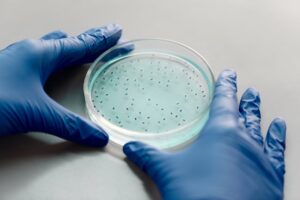1.1. Structure of Bacteria
Bacteria are single-celled organisms that lack a membrane-bound nucleus and other organelles found in eukaryotic cells. Their structure is relatively simple but efficient for their functions. Here’s a brief overview highlighting the position of DNA within a typical bacterial cell:
- Cell Envelope:
- Cell Wall: Surrounds the cell membrane and provides structural support.
- Cell Membrane (Plasma Membrane): Encloses the cytoplasm and regulates the passage of substances into and out of the cell.
- Cytoplasm:
- Gel-like substance inside the cell membrane where various cellular processes occur.
- Nucleoid: Region within the cytoplasm where the bacterial chromosome (DNA) is located. Unlike eukaryotic cells, bacteria do not have a membrane-bound nucleus. Instead, the DNA is concentrated in this central region.
- DNA (Bacterial Chromosome):
- Bacterial DNA is typically a single, circular molecule that contains all the genetic information necessary for the cell’s functions and reproduction.
- The DNA is located in the nucleoid region, where it is organized and compacted by proteins and other molecules to fit within the cell.
- Plasmids:
- Small, circular DNA molecules that are separate from the main bacterial chromosome.
- Plasmids often carry additional genes that may provide advantages such as antibiotic resistance or the ability to metabolize certain nutrients.
- Ribosomes:
- Small structures responsible for protein synthesis (translation).
- Found in the cytoplasm, ribosomes read messenger RNA (mRNA) and assemble amino acids into proteins.
- Flagella and Pili:
- Flagella: Long, whip-like structures used for movement.
- Pili: Shorter, hair-like structures that aid in attachment to surfaces or other cells.
- Inclusions (optional):
- Some bacteria may contain storage granules or inclusions where they accumulate reserves of nutrients or materials like sulfur or polyphosphate.
Understanding the basic structure of bacteria and the position of DNA within the nucleoid helps to appreciate their unique organization and efficient use of genetic information.
1.2. Principle
The principle of genomic DNA extraction from bacteria involves several key steps designed to lyse the bacterial cells, release the genomic DNA, and remove contaminants such as proteins, RNA, and cellular debris. Here’s a detailed explanation of the principles underlying each step:
1. Cell Lysis
- Mechanical and Chemical Disruption: Bacterial cells have tough cell walls (in Gram-positive bacteria) or outer membranes (in Gram-negative bacteria) that need to be disrupted to release the genomic DNA. This is achieved through mechanical disruption (e.g., bead beating, vortexing) and chemical methods.
- Enzymatic Digestion: Enzymes like lysozyme (for Gram-positive bacteria) and proteinase K are often used to degrade the cell wall/membrane and proteins, respectively. EDTA may be included to chelate divalent cations, which helps to stabilize DNA by inhibiting DNase activity.
2. DNA Stabilization and Solubilization
- After cell lysis, DNA needs to be protected from nucleases and solubilized for extraction. This is typically achieved by adding detergents (e.g., SDS) to disrupt lipid membranes and denature proteins, which helps release DNA into solution.
3. Removal of Proteins and Cellular Debris
- Phenol-Chloroform Extraction: Phenol disrupts protein structures, while chloroform helps to separate the aqueous phase (containing DNA) from the organic phase (containing proteins and lipids).
- Precipitation: Adding ethanol or isopropanol to the aqueous phase causes DNA to precipitate out of solution due to its insolubility in alcohol. Precipitation is further enhanced by the addition of salts (e.g., sodium acetate), which neutralize the negative charges on DNA molecules, promoting aggregation and precipitation.
4. Purification and Concentration
- The precipitated DNA is washed with ethanol to remove residual salts and contaminants, then resuspended in a suitable buffer (e.g., TE buffer) to provide a stable environment for storage and further analysis.
- Gel filtration or spin column methods may be employed for further purification and concentration, depending on the desired purity and concentration of the DNA.
5. Quality Control
- The extracted genomic DNA is typically quantified and assessed for purity using spectrophotometric methods (e.g., UV absorbance ratios) and/or fluorometric methods (e.g., Qubit). Agarose gel electrophoresis may also be used to assess the size and integrity of the DNA fragments.
Key Considerations
- Sterility- Maintaining sterile conditions throughout the process is crucial to avoid contamination that could compromise the quality of the extracted DNA.
- Yield- The efficiency of DNA extraction can vary depending on the bacterial species, growth conditions, and the extraction method used.
- Downstream Applications- The extracted genomic DNA is used for various downstream applications such as PCR, sequencing, cloning, and genomic analysis.
By following these principles, researchers can obtain high-quality genomic DNA suitable for a wide range of molecular biology applications, thereby enabling detailed genetic and genomic studies of bacterial organisms.
1.3. Protocol
DNA extraction from bacteria typically involves several key steps to lyse the cells, release the DNA, and purify it from cellular debris and proteins. Here’s a general protocol for DNA extraction from bacteria:
Materials Needed:
- Bacterial culture
- Buffer solutions (e.g., Tris-EDTA buffer, lysis buffer)
- Lysozyme (optional, for Gram-positive bacteria)
- Proteinase K
- SDS (Sodium Dodecyl Sulfate)
- Phenol:chloroform
alcohol (25:24:1) - Chloroform
alcohol (24:1) - Ethanol
- RNase A (optional, for RNA digestion)
- TE buffer (Tris-EDTA buffer)
Protocol:
- Prepare Bacterial Pellet:
- Grow the bacterial culture in an appropriate medium and volume until it reaches the desired growth phase (usually mid-log phase for maximum DNA yield).
- Transfer the bacterial culture to a centrifuge tube and centrifuge at high speed (10,000 x g) for 5 minutes at 4°C to pellet the cells.
- Cell Lysis:
- Carefully remove the supernatant and resuspend the bacterial pellet in an appropriate volume of TE buffer or lysis buffer.
- Add lysozyme (if using, for Gram-positive bacteria) and/or proteinase K to the resuspended cells. Lysozyme breaks down the cell wall of Gram-positive bacteria, while proteinase K digests proteins.
- Optionally, add SDS to break down the cell membrane and denature proteins.
- Incubation:
- Incubate the mixture at an appropriate temperature (typically 37°C) for 30 minutes to several hours, depending on the specific protocol and the type of bacteria.
- Cell Disruption:
- After incubation, disrupt the bacterial cells further by vortexing or using a bead beater. This step helps to release the DNA from the cells.
- Organic Extraction:
- Add an equal volume of phenol:chloroform
alcohol to the lysate. Mix thoroughly by vortexing and then centrifuge at high speed (10,000 x g) for 10 minutes at 4°C. - Transfer the upper aqueous phase (containing DNA) to a new tube, being careful not to disturb the interphase or organic phase.
- Add an equal volume of phenol:chloroform
- Precipitation of DNA:
- Add 0.1 volume of 3 M sodium acetate (pH 5.2) and 2.5 volumes of cold ethanol (95-100%). Mix gently by inverting the tube several times.
- Incubate the mixture at -20°C for 15-30 minutes to allow DNA precipitation.
- Centrifuge at high speed (10,000 x g) for 10-15 minutes at 4°C to pellet the DNA.
- Washing and Resuspension:
- Carefully remove the supernatant and wash the DNA pellet with cold 70% ethanol.
- Air-dry the pellet briefly and then resuspend the DNA in an appropriate volume of TE buffer or sterile water.
- Quality Control:
- Measure the concentration and purity of the extracted DNA using a spectrophotometer (e.g., Nanodrop) or fluorometer (e.g., Qubit).
- Optionally, perform agarose gel electrophoresis to check the integrity of the DNA.
- Storage:
- Store the extracted DNA at -20°C or -80°C for long-term storage, or use immediately for downstream applications such as PCR, sequencing, or cloning.




